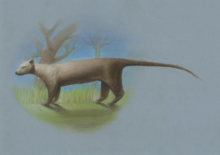| Cryptoprocta spelea Temporal range: Holocene
| |
|---|---|

| |
| Scientific classification | |
| Domain: | Eukaryota |
| Kingdom: | Animalia |
| Phylum: | Chordata |
| Class: | Mammalia |
| Order: | Carnivora |
| Suborder: | Feliformia |
| Family: | Eupleridae |
| Genus: | Cryptoprocta |
| Species: | †C. spelea
|
| Binomial name | |
| †Cryptoprocta spelea G. Grandidier, 1902
| |

| |
| Subfossil sites for Cryptoprocta species: blue—C. spelea; green—C. ferox and C. spelea; red—C. ferox[2] | |
| Synonyms[3] | |
| |
Cryptoprocta spelea, also known as the giant fossa,[4] is an extinct species of carnivore from Madagascar in the family Eupleridae which is most closely related to the mongooses and includes all Malagasy carnivorans.
It was first described in 1902, and in 1935 was recognized as a separate species from its closest relative, the living fossa (Cryptoprocta ferox). C. spelea was larger than the fossa, but otherwise similar. The two have not always been accepted as distinct species. When and how C. spelea became extinct is unknown; there is some anecdotal evidence, including reports of very large fossas, that there is more than one surviving species.
The species is known from subfossil bones found in a variety of caves in northern, western, southern, and central Madagascar. In some sites, it occurs with remains of C. ferox, but there is no evidence that the two lived in the same places at the same time. Living species of comparably sized, related carnivores in other regions manage to coexist, suggesting that the same may have happened with both C. spelea and C. ferox. C. spelea would have been able to prey on larger animals than its smaller relative could have, including the recently extinct giant lemurs.
- ^ Hoffmann, M.; Hawkins, F. (2015). "Cryptoprocta spelea". IUCN Red List of Threatened Species. 2015: e.T136456A45221489. doi:10.2305/IUCN.UK.2015-4.RLTS.T136456A45221489.en. Retrieved 27 March 2021.
- ^ Cite error: The named reference
Gea141was invoked but never defined (see the help page). - ^ Cite error: The named reference
Gea130was invoked but never defined (see the help page). - ^ Alcover and McMinn, 1994, table 1
